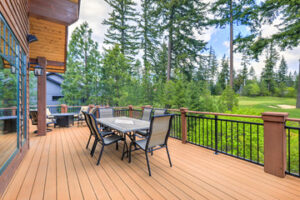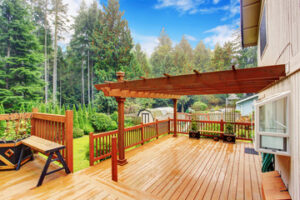Building a deck requires a lot of lumber. Local residential building codes dictate the size of lumber required for various structural components of the deck.

Use batter boards and mason’s strings to plot footing locations. A rough outline drawn on the ground with boards saves time and gives you a reference for setting post bases and marking footing locations. Contact Deck Builder Stafford for professional help.
A deck is a great outdoor space that can be turned into a beautiful al fresco family room, area for entertaining or just somewhere to relax. Decks can be built in a variety of ways, depending on the location, size and shape of your property. Before construction begins, you will want to carefully consider how your deck will be used and what the weather elements will do to it. A professional contractor can help you plan the design of your deck and choose materials based on your budget and needs.
Once the foundation is complete, your contractor will begin installing the principle framework for the deck. This will include the rim joists, which form the outer edge of your deck; interior joists, which are spaced around 12 or 16 inches apart; and perpendicular beams. The rim joists will be attached to the posts you installed, while the other end will rest on top of a ledger board, or in some cases, will be anchored directly to your house framing (this requires the removal of siding).
The next step is to install the beams. In most cases, a single horizontal beam will be sufficient to support your deck; however, larger decks may require two or more of these beams. You will also need to add a number of vertical beams, depending on the layout and height of your deck. In addition, the vertical beams will need to be reinforced with shear studs or “Nelson” studs.
It is important to note that these shear studs can be difficult or impossible to locate, especially in the low points of a beam. For this reason, we recommend only drilling in the high points of a beam and avoiding the low points, where conduits may be hidden from view.
Materials
Before you can build your deck, you’ll need to gather a variety of materials. You’ll need framing lumber such as cedar, pine or fir, plus screws, nails and fasteners that are labeled for use with treated wood (i.e., stainless steel or hot-dipped galvanized). You may also need a variety of clamps such as sliding, squeeze and pipe clamps for holding pieces together. Depending on your design, you’ll also need access to a sander that features a random orbit for creating custom looks and for easing sharp edges from cuts made with a handsaw or power saw.
The type of decking material you choose will depend on your budget and the climate in your area. Pressure-treated wood is typically the least expensive decking option, but it requires staining on a yearly or every other year schedule to avoid rot and insect damage. Other wood options include tropical hardwoods such as ipe, which are known for their beauty and durability but can be more costly than other materials.
Plastic or composite lumber offers a low-maintenance alternative to traditional wood. It’s essentially made from recycled plastic, with manufacturers adding additives to make it tough enough for deck building applications. It resists rot and won’t splinter, and it’s completely weatherproof. Manufacturers can even mold surface textures to resemble graining for visual appeal.
Before you start purchasing your materials, check to see whether a permit is required for your project and what rules and regulations are in place regarding deck construction in your area. In addition, consult a span table to determine the size of joists your deck will require. These charts provide information about how much weight a joist can support, and they also detail the spacing required between each joist.
Footings
When building a deck, footings provide support and help ensure that live and dead weight are evenly distributed. They also prevent the deck from shifting and settling over time, making it easier to maintain the structure.
The footings are secured to the ground using concrete and must be a minimum of 12 inches below grade, or the local frost depth. If you’re unsure of how deep the footings should be, refer to your framing plan. They may not call out the exact location of each footing, but they will show joist spacing and centerlines. You can use a simple tape measure to mark the distance from the foundation to each end of the joist.
While digging for footings, make sure to avoid anything underground like plumbing pipes or cables that could be broken by the shovel. This is a serious safety issue and can be costly to repair. It’s also a good idea to have someone nearby who can watch for any electrical lines running under the ground that might be hit by the shovel.
One way to save on footing costs is to use a precast footer block. These are essentially blocks of concrete with holes in them for the posts. This is an alternative to traditional concrete footings, but it’s still important to check with the local building code to ensure that the blocks meet requirements such as a minimum depth and a flat surface.
A newer type of footing, called a helical pile, is driven into the ground in a similar manner to screwing in nails. These are becoming more common amongst professional contractors as they’re a quicker and easier alternative to other types of footings.
Railings
The railings of a deck provide safety and a way to dress up the overall look. They’re available in many materials, from wood and aluminum to composite and PVC. There are also a wide variety of infill styles and top rail designs, so you can build your deck to match your style.
A good rule of thumb is to use pressure-treated lumber for the beams and joists, and to use a hardwood like ipe or a premium composite material for the railing. This will help ensure the deck is safe and durable for years to come.
When it comes to the actual railing, it’s important to follow local building codes when determining the height and distance between posts. You’ll also want to make sure the top of the guardrail can withstand a 200-pound force applied to it in any direction. Many older decks’ guardrail posts weren’t strong enough for this, and building inspectors have become more vigilant about this issue.
To increase the strength of the railings, make sure the bottom rail is on edge for lateral resistance and that the top rail is horizontal to resist sagging. In addition, it’s a good idea to add a small support piece between the bottom and top rail.
If you’re using 4×4 posts, they should be notched and lag bolted to the rim joists with 3/8-inch or 1/2-inch lag screws or structural fasteners such as LedgerLoks. This will increase the strength of the connection, as the joists are able to transmit more force to the post. When you’re using steel posts, be sure the coating is intact and that no paint has sloughed off to expose the base metal. This will reduce the risk of rust and corrosion in wet climates.
Furniture and Decor
When choosing furniture and decor for your deck, consider the style of your house and how it will match with a new outdoor space. Also think about how the deck will be used. If it’s going to be a gathering spot for family and friends, you’ll want enough seating for everyone to sit together comfortably. If you plan to use the deck mostly for sunbathing, go for lounge chairs instead of a traditional dining table.
Decks made from rustic materials like wood are ideal for decorating with natural, earthy colors. Add a jute rug to warm up the floor and inject colorful decor pieces into the overall design. Bright-colored throw pillows and an accent table are great choices. You can also add a touch of color by hanging multicolored pom pom tassels or painting pots. Light fixtures that occupy floor space aren’t the best choice for small decks because they can crowd the area and make it feel cramped. Wall-mounted options are a good alternative because they don’t take up much room and provide ample illumination without taking up floor space.
If you’re planning to build a fire pit on your deck, position it along the longest wall that faces the view. Then place seating for two chairs diagonally in front of it and a coffee table between them. This asymmetrical arrangement creates a focal point while making it easy to relax by the fire and enjoy the view.
Deck building is a big project, and there’s a lot to consider before you get started. To help ensure that you’re getting the best possible outcome, choose a qualified contractor who has experience working on similar projects.
